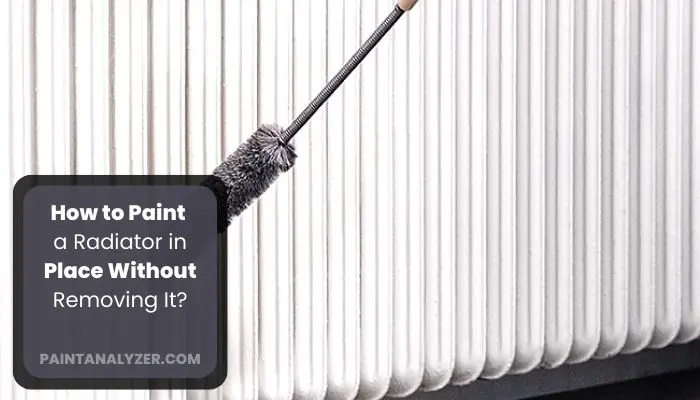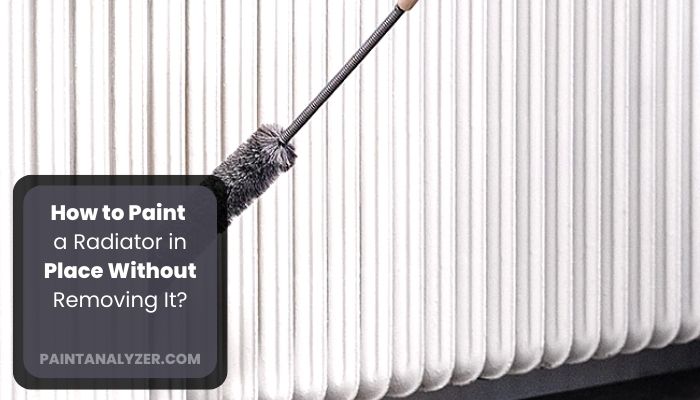There are a few reasons you might need or want to paint a radiator in place without removing it. Maybe you’re working with a historic home that has beautiful, original radiators that you don’t want to remove and replace. Or, perhaps, you’re working with it that’s difficult or impossible to remove without damaging it.
Whatever the reason, painting a radiator in place can be challenging. But, with the proper preparation and technique, it can be done! So here we’ll show you how to paint it in place without removing it and give some tips about it.

How to paint a Radiator without Removing It? A Step by step guide
When your radiator looks a little worse for wear and you’re thinking about giving it a fresh coat of paint, you might wonder if you can do it without removing the radiator from the wall. The good news is that it is possible to paint a radiator without removing it, but there are a few things you need to keep in mind to get a good finish.
Step 1: The space should be ventilated
Before you start working with Paint or any other materials, ensure to ventilate the room you’ll be working in. This will help prevent fumes or odors from building up and becoming overwhelming.
Step 2: Prep the radiator
Once the room is ventilated, you can start prepping the radiator. Use a damp cloth to wipe down the surface of the radiator. This will help remove any dirt or debris that could interfere with the paint job.
Step 3: Apply primer on the radiator by spray
Now it’s time to start painting! Begin by applying a primer to the radiator. This will help the Paint to adhere better and create a more even finish. Once the primer is dry, you can start painting the radiator with your chosen color.
Step 4: Spray the Paint
When applying the Paint, it’s best to use a spray can. This will help to avoid any drips or streaks. Apply a few light coats of Paint, allowing each coat to dry before adding the next.
Step 5: Add any final touches
Once the Paint is dry, you can add any final touches. This could include adding new hardware or trim. Then, if you’re happy with the way the radiator looks, you can put everything back in place and enjoy your unique decoration!
How do you use a Brush to Paint a Radiator?
There is another way to paint a radiator with a brush. You can easily give it a makeover with a fresh coat of Paint. Here’s how to do it:
Materials
- a paintbrush
- a can of Paint
- a ladder
- a drop cloth
Step 1: Prepare the Area
- Remove any loose paint from the radiator with a paintbrush.
- Wipe down the radiator with a damp cloth to remove any dirt or debris.
- Place a drop cloth on the floor beneath the radiator.
Step 2: Paint the Radiator
- Paint the radiator with a brush, using even strokes.
- Start with the top of the radiator and work your way down.
- Let the first coat of Paint dry completely before adding a second coat.
Step 3: Clean Up
- Remove the drop cloth from the floor.
- Wash the paintbrush with soap and water.
Which Paint Should you Use on Radiators?
When your home has old, outdated radiators, you may wonder what type of Paint to use to update them. There are actually a few different types of Paint that can be used on radiators, and the best type for your project will depend on the look you’re going for and the condition of the radiator itself. When you want a high-gloss finish, you’ll need to use an oil-based paint.
These paints aren’t as durable as other types, so they may not be ideal when your radiator is in poor condition. When durability is more important to you than appearance, consider using latex paint instead. These paints are much more durable than oil-based paints, so they’ll stand up better to wear and tear.
Another factor to consider is the color of your radiator. If it’s a dark color, you may want to use light-colored paint so that it doesn’t absorb too much heat. On the other hand, when your radiator is already light-colored, you can use any color of Paint that you like.
Remember that darker colors will absorb more heat than lighter ones. No matter what type of Paint you choose, make sure to follow the manufacturer’s instructions carefully in order to get the best results. If you’re not sure which type of Paint to use, ask a professional at your local hardware store for advice.
Problems with painting radiators
When you have ever painted a radiator, you know that it can be a bit of a challenge. The good news is that there are some tips and tricks that can help make the process go more smoothly. Here are some of the most common problems people run into when painting radiators and how to avoid them:
Paint drips
This is probably the most common issue people run into when painting radiators. To avoid paint drips, make sure to use painter’s tape around the edges of the radiator before you start painting. This will create a barrier between the Paint and the surface of the radiator, so any drips will just land on the tape and not on the radiator itself.
Uneven coverage
Another common problem is getting uneven coverage when painting radiators. To avoid this, use a paintbrush to apply an even layer of Paint over the entire surface of the radiator. Once you have done this, use a roller to smooth out any brush strokes and ensure even coverage.
Bubbling Paint
When your Paint starts to bubble up after you have applied it to the radiator, this means that there was moisture present on either the surface of the radiator or in the air when you were painting. To avoid this problem, ensure that both the radiator’s surface and your environment are completely dry before beginning to paint.
Spray vs. Brush: How to Paint a Radiator?
Is It Necessary to Paint Over the Primer When Painting a Radiator in Place?
When painting a radiator in place, it is necessary to paint over the primer to ensure a smooth and durable finish. Leaving primer unpainted results in an uneven appearance and reduces the longevity of the paint job. Properly painting over the primer will ensure a professional and lasting result.
Conclusion
In conclusion, if you want to paint a radiator without removing it by spray, you can follow the steps outlined in this guide, and you can also use a brush to apply the Paint evenly to the radiator. Make sure to use paint that is specifically designed for radiators so that you don’t run into any problems.
You can either spray or brush the Paint onto the radiator, depending on your preference. So we hope you found this guide helpful! Thank you for reading!
